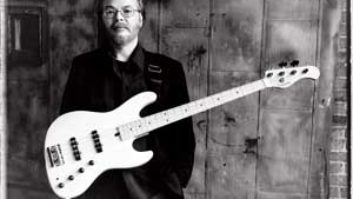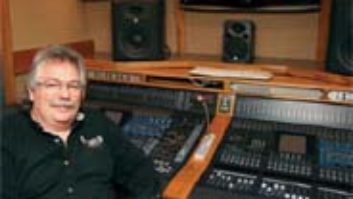
You know the hits, now read the book. You’ve read the book, now listento the tapes. You’ve listened to the tapes, now watch the movie. You’veseen the movie, now buy the DVD.
No, it’s not Harry Potter and the Invisible Weapons of MassDestruction or The Matrix Regurgitated. For us in the musicbiz, this year’s superhot multimedia property is Standing in theShadows of Motown, a 16-year-long project that just keeps gettingbetter and better. The latest incarnation is so good, in fact, that itactually inspired me to go out and buy a DVD player.
It all began in the late ’80s when Philadelphia-basedmusician/writer/arranger/guitarist/fanatic Allan Slutsky, who publishesunder the name Dr. Licks, decided to write a book about James Jamerson,probably the most influential bassist in rock ‘n’ roll history.Jamerson was one of the legendary jazz-trained Motown session playerswho called themselves The Funk Brothers, and whose work supportedhundreds of hit records; as the opening titles of the movie (based onthe book) tell us, the Brothers have “more Number One recordsthan The Beatles, the Beach Boys, the Rolling Stones and Elvis Presleycombined.”

Jamerson never garnered much attention for himself, but as anyone(especially a bass player) who has ever listened closely to his tracksknows, he was nothing less than a genius. He drove the Motown rhythmsection with lines that were melodic, inventive and constantly inmotion, defining the beats and harmonic structures by filling thespaces between them rather than simply coming down straight on them.Slutsky’s biographical/instructional book, Standing in the Shadowsof Motown — The Life and Music of Legendary Bassist JamesJamerson, which came out in 1989 (and was covered in Mix in October1990), supports Jamerson’s reputation with the strongest possibleevidence. Besides detailing Jamerson’s life, which ended tragically atthe young age of 47 after years of alcohol abuse, Slutsky’s book alsofaithfully transcribes some four dozen of Jamerson’s most amazing bassparts, from “Ain’t No Mountain High Enough” to “YouCan’t Hurry Love.”
And there’s more: Recordings of the transcriptions, along with somegreat interviews of Jamerson’s friends and fans, are featured on twoCDs that are stuck into the back of the book. (In the first printings,these were cassettes.) The 24 players on the recordings includeluminaries like John Entwistle, Will Lee, Jack Bruce, John Patitucciand Jamerson’s son, James Jr., who also talk about their love of andrespect for the Motown bassist’s work. The recordings are in the old“music-minus-one” style: The bass part is on one channeland the rest of the instrumental tracks are on the other. Slutsky’sbook is still available, and for about the cost of a six-pack ofrewritable DVDs, you can’t ask for a more valuable educationaltool.

But Slutsky, who knew he was onto a good thing, wasn’t finishedthere. Paul McCartney’s opening greeting on the CD remarks, “Ihope this project goes on to greater heights.” He didn’t know howright he would be. After the book came out (and won a few awards), theauthor, having made friends with many of the musicians who worked withJamerson, began to think about a more comprehensive project —aimed at a wider audience — that would involve all of the FunkBrothers. He linked up with documentary producer and director PaulJustman and producer Sandy Passman, and got financing from a couple ofmusician/fans of Motown. The team organized a series of live shows atthe Royal Oak Music Theater in Detroit, featuring seven of thesurviving original Brothers and a supporting cast of a couple of dozenother first-class players and singers. The musicians, who hadn’t playedtogether in years, rehearsed for a week, using Slutsky’s transcriptionsto support their own memories, some of which were hazy. (“Did Ireally play that?” Slutsky heard more than once.) The concertswere shot with multiple 35mm cameras and recorded and mixed by theredoubtable Kooster McAllister.
Surrounding the concert footage, we get to see the Brothersrehearsing, reminiscing and articulately explaining the elements oftheir musical success. Because many of the original singers are retiredor dead, the lead vocals at the concert were handled by some newertalents — Ben Harper, Méshell Ndegéocello and ChakaKahn among them — but the point is well made that the vocalistsin Motown were often not the most important factor in the label’smusical success: It was the band. “You could take a chicken,bring him into the studio and have him squawk on two and four, and youwould have a hit record,” one of the Brothers declares in theDVD’s supplementary material, and you realize that he’s probablyright.
There were, for example, three guitarists on many of the sessions,and when a new arrangement came in, they would divvy up their parts,virtually in seconds: one playing a riff down low, another the backbeathigh up the neck, and the third a syncopated pattern in the middle.They created textures that were, well, funky and unique to Motown,which acolytes — even those as brilliant as The Beatles and theStones — could only hope to approximate, never duplicate.
The performances from a mad-hatted Bootsy Collins on “CoolJerk” and “Do You Love Me,” and by an ecstatic JoanOsborne on “Heat Wave” and “What Becomes of theBroken Hearted” are fabulous, as is Tom Scott’s alto sax solo on“Shotgun.” But it’s the Funk Brothers, cooking along ontracks that they defined 30 and 40 years ago, and the joy in theirfaces, who really catch your eye and put a lump in your throat. DrummerUriel Jones says, “After so many years, we were all a littleunsure about playing together. But we surprised ourselves…we hadthe Motown sound.” Correction: They were the Motownsound.
The filmmakers do a fine job of framing the music in the context ofthe tumultuous world that inspired the sound. As the film’s narratornotes, “Motown played a pre-eminent role in the culturalsoundtrack” that accompanied, and commented on, the events of the’60s. When the film then segues into Chaka Khan’s rendition of“What’s Going On,” arguably the pinnacle of the Motown era(and the first record on which the individual musicians were credited),it is at once joyous and chilling.
None of the Motown session players became rich, but they weren’tripped off as badly as many musicians of the time, and some were ableto afford respectable middle-class existences on what they earned inBerry Gordy’s studio and elsewhere. The movie, which was produced withGordy’s cooperation (he still controls a large share of the music,after all), treads lightly on this area, but in one interview, drummerJones, who still does some music teaching, makes an apt allusion to theeconomic dichotomy: “The kids say, ‘If you played on allthose hit records, what are you doing teaching us?’”
While Motown was predominantly a black enterprise, not all of theplayers were African-American. Joe Messina was the “whiteboy” sitting between two black Brothers. “They called us‘The Oreo Cookie Guitar Section,’” he says with alaugh. But then he and percussionist Jack Ashford recall a tense momentafter a late-night session in July of 1967, when tensions betweenpolice and the black community reached a fever pitch and Detroit wasrioting. “Everything was burning down,” says Ashford,“and you protect your family. These were my brothers here. Ididn’t think about color. I would have gone down for them, even at thehands of a black brother.” Méshell Ndegéocellointerviews white bassist Bob Babbitt, who breaks down when he recallshow he was treated by the other players after Martin Luther King Jr.’sassassination the next year. “Had the role been reversed and wehad been in a predominantly white area and something broke out, I wouldhave took a bullet for Jack,” he says.
There are many other poignant scenes, such as when the players visitthe long-unused basement of Gordy’s old Detroit home. Now a museum, theold Studio A at Hitsville USA was otherwise known as “TheSnakepit.” “It’s still in there,” says Ashford,referring to the spirit and prayers of Gordy and all who worked there.There’s great sadness and frustration associated with the place, too:Slutsky relates one tale when he was at a restaurant with normallyarticulate guitarist Robert White, who played the lead line on“My Girl.” When that song came on the sound system, Whitestarted to tell the waiter that it was he who was playing on therecord, but got too embarrassed to finish his sentence and, instead,just ordered his barbecued chicken. Says Slutsky, “I knew at thatpoint, Robert desperately needed some recognition in hislifetime.” That recognition is finally at hand, but,unfortunately, White didn’t live long enough to receive it.
To see the movie in a theater, which I did last year, is wonderful.But even so, the DVD adds a lot to the experience. On disc, the film isdivided into 35 intelligently chosen chapters, which makes it easy tojump around, and also makes it possible to just watch the musicsequences. There are the usual extra audio tracks, which include2-channel and 5.1 Dolby and 6.1 DTS surround, running commentary fromSlutsky and Justman and a reasonably informative MST3K-style onscreen“trivia track.” Extra material (much of which comes on asecond disc) includes a black-and-white video of interviews with someof the Brothers (including White) from 1993 that helped raise fundingfor the film; biographical interviews; tributes to the Brothers who’vedied; scenes that had to be cut from the film due to time constraints;a bunch of onstage, club and studio jam sessions, some of which aredone “multi-angle”; and a delightful and touching segmententitled “Dinner With the Funks,” which I would have beenhappy to watch for an hour or more.
And the project keeps going. The Funk Brothers themselves have goneon tour around the U.S.; this fall and winter, they are scheduled to goto Europe and Australia. Slutsky is continuing to explore the oldtracks, and is planning a release of some remixes of the originalMotown multitrack masters, which will showcase instrumental parts andlicks hidden in well-known songs that no one has heard before.“Pushing up faders and punching mute buttons, and hearing all ofthis amazing stuff,” he says, “it’s a musician’sdream.”
•••
From literally the other side of the planet comes news of anothergreat loss to the music world: the death of Italian composer LucianoBerio on May 28 at age 77.
Berio was an extraordinarily prolific composer and wrote for allcombinations of instruments and voices, including 14 Sequenzas:fiendishly intricate pieces for solo instruments. His monumental“Sinfonia” brought together the disparate forces of the NewYork Philharmonic and baroque-jazz group the Swingle Singers in thelate 1960s. But in my opinion, his most amazing works were his earlyelectronic pieces, dating back to the ’50s: intense and evocative tonepoems and collages that often featured the breathtakingly nimblesoprano voice of his first wife, American-born Cathy Berberian. Hisworks were as good a refute as you’ll ever need to use against thosewho argue that electronic music was sterile and inhuman.
I was in high school when I stumbled across his 21-minute acid-flashaudio horror movie Visage and Thema, his deconstructionof a part from James Joyce’s Ulysses. Thema uses virtuosotape-editing techniques that still elicit gasps of admiration from mystudents when I explain patiently to them that, no, Pro Tools wasn’tavailable in 1958. (In fact, somebody once told me that when Berio wasshown Pro Tools for the first time, he exclaimed, “So why did Iwork so hard?”)
Up there with Varése, Ussachevsky, Cage and Stockhausen, Beriowas a god to those of us who listened to electronic music at thebeginning of its evolution. I even got to work with him once in theearly ’80s. A local contemporary-music group putting on a concert ofhis music suddenly realized that they needed a small pipe organ for apiece and the hall didn’t have one. For some reason, they knew I had acomputer-based synthesis system that could do a reasonably good pipeorgan imitation. (It was an alphaSyntauri system on an Apple II, whichotherwise sounded awful.) Though the composer initially looked upon thecontraption with an expression that alternated between horror andcontempt, he smiled at me afterward and admitted that it didn’t soundtoo bad. In fact, the whole concert was terrific.
As is true of Jamerson, there is much education to be gleaned fromlistening to the music of Berio. Visage and Thema areavailable on CD, although on the relatively hard-to-find Dutch BVHAASTlabel (www.xs4all.nl/~wbk/BVHAAST.html). Needless to say,it’s worth hunting down.
Paul Lehrman’s personal musical fanaticism can be viewed atantheil.org, whilehis past rantings are available at insideraudio.com.

Bonus photographs from Standing In the Shadows ofMotown:

Robert White (left) and Joe Messina in Studio A at Hitsville USA
Photo courtesy the Funk Brothers/Property of Artisan Entertainment

From left: Funk Brothers Jack Ashford, Pistol Allen, Joe Hunter andEddie Willis with Joan Osborne
Photo: Karen Sas/Property of Artisan Entertainment

Bob Babbitt (left) and Eddie Willis with an impassioned Ben Harper(center) performing “Ain’t Too Proud to Beg.”
Photo: Karen Sas/Property of Artisan Entertainment

Director Paul Justman on the stage of the Royal Oak Music Theatergiving instructions to the film crew.
Photo: Karen Sas/Property of Artisan Entertainment





